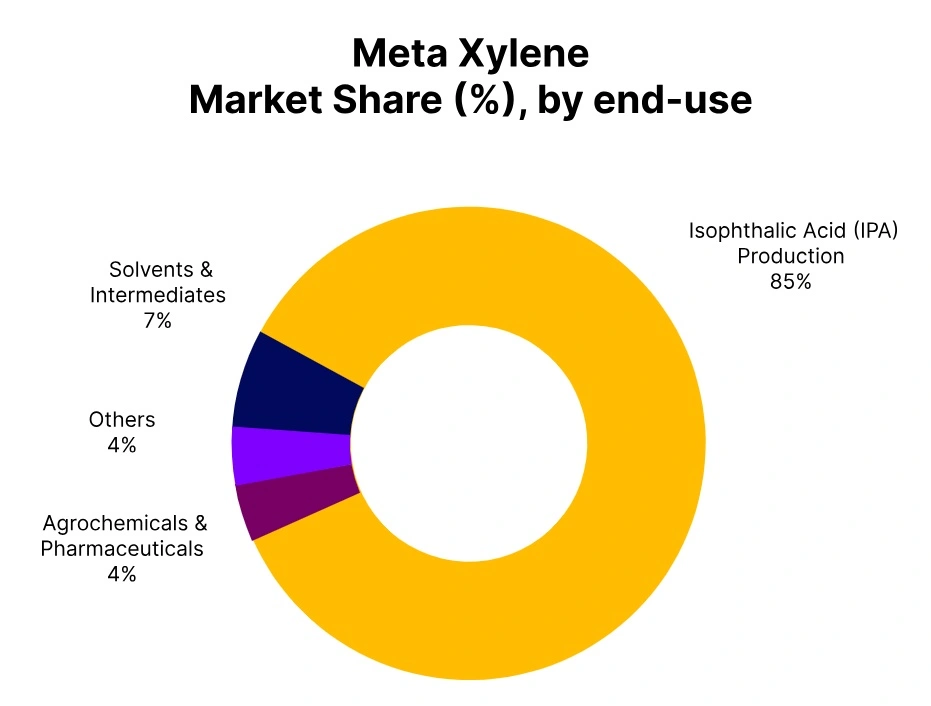Price-Watch’s most active coverage of Meta Xylene price assessment:
- Industrial Grade (>99%) CIF Nhava Sheva (Japan), India
- Industrial Grade (>99%) CIF Laem Chabang (Japan), Thailand
- Industrial Grade (>99%) CIF Port Kelang (Japan), Malaysia
- Industrial Grade (>99%) CIF Shanghai (Japan), China
- Industrial Grade (>99%) FOB Tokyo, Japan
Meta Xylene Price Trend Q3 2025
In Q3 2025, the global Meta Xylene market witnessed a gradual decline in prices, primarily driven by subdued demand and cautious buying behaviour across key regions. Despite stable feedstock costs such as Reformate and Mixed Xylene, limited spot activity and moderate inquiry levels kept seller sentiment bearish. Most transactions were confined to contractual volumes, as buyers avoided from bulk purchases due to adequate stock levels and weak downstream signals.
Suppliers were compelled to adjust offers lower to stay competitive, but overall market momentum stayed soft. The Meta Xylene price trend in global markets was negative throughout the quarter, and Meta Xylene prices in Q3 2025 were assessed within a moderate range, reflecting balanced supply against restrained demand.
Japan
Meta Xylene Export prices FOB Tokyo, Japan, Industrial Grade (>99%).
In Q3 2025, Meta Xylene prices in Japan under FOB Tokyo terms went down due to muted international buying interest and cautious sentiment across key export destinations. Despite stable upstream costs for Reformate and Mixed Xylene, limited spot demand weighed on seller confidence. Inquiries from overseas buyers remained low throughout the quarter, prompting Japanese suppliers to reduce their offer prices in a bid to encourage trades.
Domestic production continued at steady rates, but weaker market sentiment globally prevented any upward momentum in pricing. In September 2025 Meta Xylene prices reflected a decline of 6.52% from the previous month. The Meta Xylene price trend in Japan reflected bearish conditions, with Meta Xylene price in Japan assessed between USD 1340–1515 per metric ton, showing a 3.36% decrease over the quarter.
India
Meta Xylene Import prices CIF Nhava Sheva, India, Industrial Grade (>99%).
In Q3 2025, Meta Xylene prices in India under CIF Nhava Sheva terms saw a small decline, attributed to reduced freight advantages and limited international buying momentum. While there were some fluctuations in upstream costs for Reformate and Toluene, they had slight impact on the broader market sentiment. Domestic buyers were conservative in their buying approach, citing ample inventories and subdued downstream demand.
The number of inquiries remained stable, though most were limited to short-term requirements. In September 2025 Meta Xylene prices reflecting a steep decrease of 6.41% compared to the previous month. Overall, the Meta Xylene price trend in India stayed on a downward track, with prices falling within the range of USD 1350–1525 per metric ton, reflecting a 2.10% shift in Q3. Export offers from Japanese suppliers also followed a similar trend.
Thailand
Meta Xylene Import prices CIF Laem Chabang, Thailand, Industrial Grade (>99%).
In Q3 2025, Meta Xylene prices in Thailand under CIF Laem Chabang terms weakened due to soft regional demand and easing freight benefits, which reduced the cost competitiveness of imports. Domestic traders reported slow-moving inventory, while overseas suppliers, particularly from Japan, lowered offer levels to stimulate inquiries. Despite consistent availability of key feedstocks like Mixed Xylene and Reformate, market activity remained limited throughout the quarter.
The number of spot deals was noticeably lower than the previous quarter, and most buyers continued to adopt a wait-and-watch approach. In September 2025 Meta Xylene prices declining by 6.21% from the previous month. The Meta Xylene price trend in Thailand declined steadily, with prices ranging between USD 1390–1560 per metric ton, marking a 3.36% drop for the quarter.
Malaysia
Meta Xylene Import prices CIF Port Kelang, Malaysia, Industrial Grade (>99%).
In Q3 2025, Meta Xylene prices in Malaysia under CIF Port Kelang terms went down slightly, although improved freight availability helped moderate overall landed costs. Market sources noted a marginal increase in the number of inquiries, but transactions remained limited to contractual volumes. The upstream environment remained overarchingly stable, with consistent costs for Reformate and related aromatics.
However, buyers remained cautious, citing oversupplied conditions in both domestic and imported stockpiles. Japanese-origin material saw competitive pricing, but most discussions stayed within a tight range. In September 2025 Meta Xylene prices marking a 5.70% decreased from the previous month. The Meta Xylene price trend in Malaysia moved downward over the quarter, with prices assessed between USD 1385–1550 per metric ton, reflecting a 3.04% shift from the previous period.
China
Meta Xylene Import prices CIF Shanghai, China, Industrial Grade (>99%).
In Q3 2025, Meta Xylene prices in China under CIF Shanghai terms decreased amid reduced downstream buying interest and steady freight availability. While feedstock input from Japanese exporters remained stable, domestic market participants reported a slowdown in spot purchases as buyers depended on existing inventories. There was a noticeable decline in the number of spot inquiries, and most negotiations concluded at lower levels.
Although upstream support from Mixed Xylene and Reformate stayed firm, it did not translate into price resilience. In September 2025 Meta Xylene prices declining by 6.35% from the previous month. The Meta Xylene price trend in China remained soft, with prices falling within the range of USD 1380–1555 per metric ton, marking a 3.28% decrease over the quarter.




